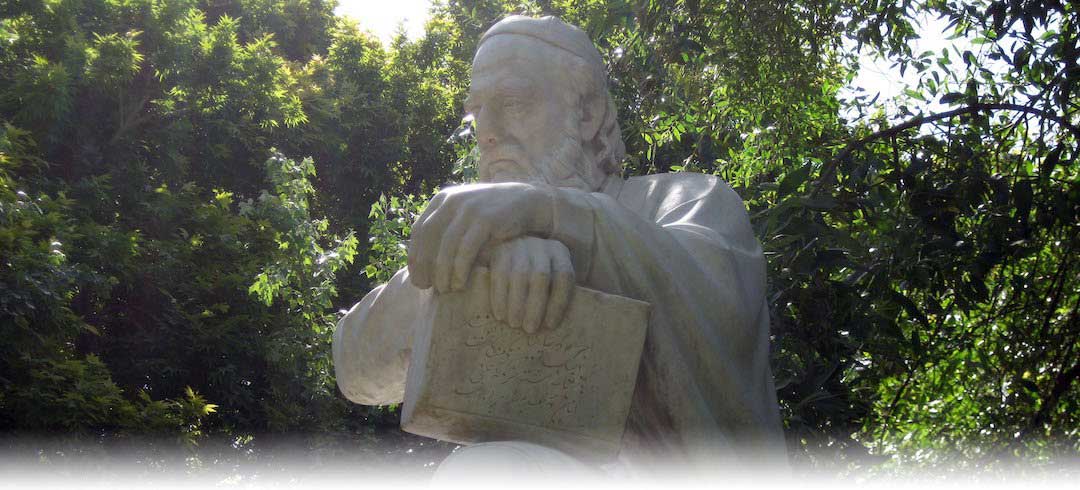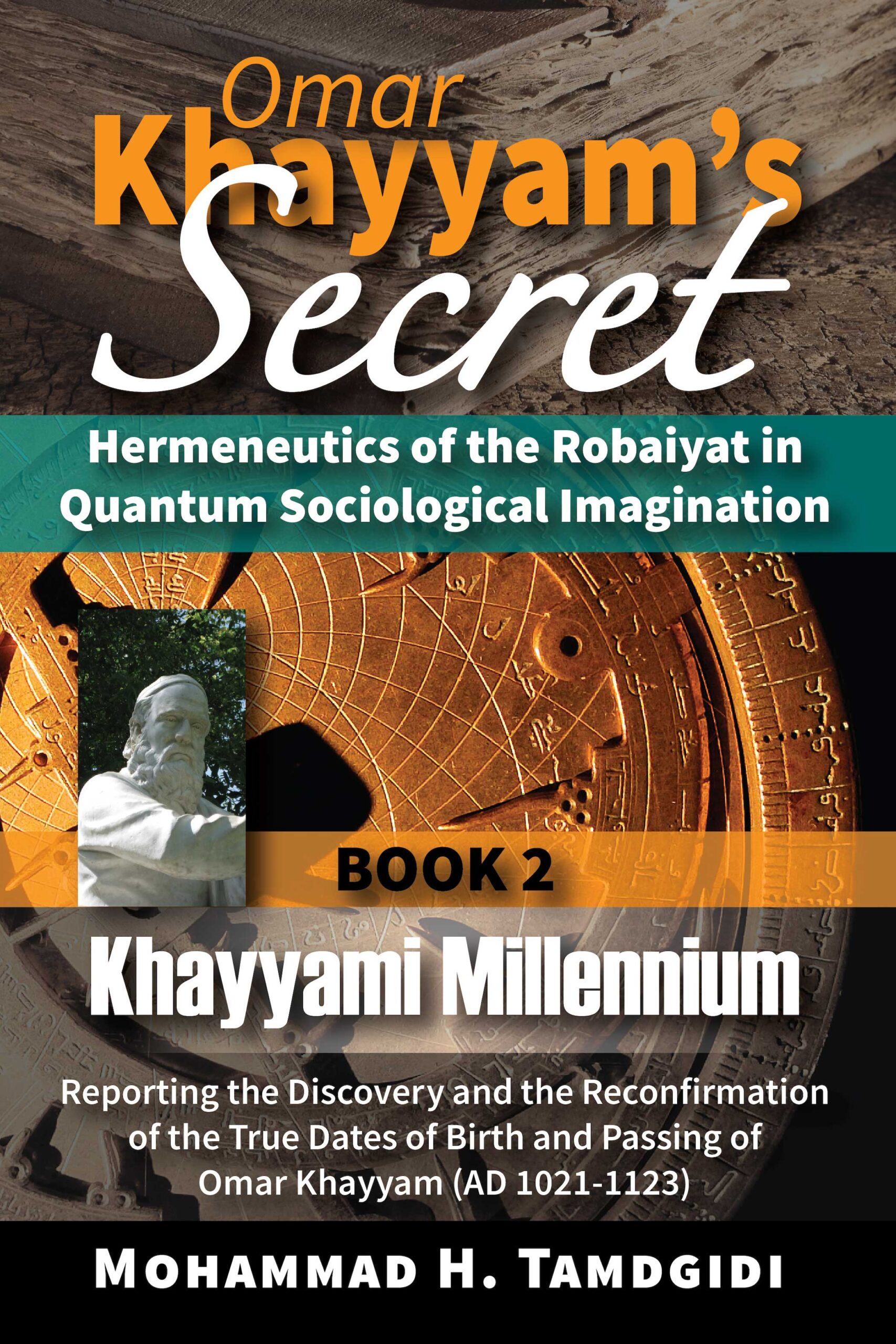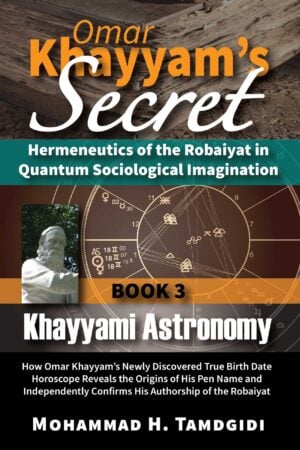Book Section: CHAPTER V — Omar Khayyam’s True Date of Passing Discovered and Reconfirmed: Superposing the Birth Date Findings With All “Tarabkhaneh,” “Chahar Maqaleh,” And “Tatemmat Sewan el-Hekmat” Accounts — by Mohammad H. Tamdgidi
$20.00
This essay, titled “Omar Khayyam’s True Date of Passing Discovered and Reconfirmed: Superposing the Birth Date Findings With All “Tarabkhaneh,” “Chahar Maqaleh,” And “Tatemmat Sewan el-Hekmat” Accounts,’” is the fifth chapter of the second book of the twelve-book series Omar Khayyam’s Secret: Hermeneutics of the Robaiyat in Quantum Sociological Imagination, authored by Mohammad H. Tamdgidi. The second book is subtitled Khayyami Millennium: Reporting the Discovery and the Reconfirmation of the True Dates of Birth and Passing of Omar Khayyam (AD 1021-1123).
Description
Abstract
This essay, titled “Omar Khayyam’s True Date of Passing Discovered and Reconfirmed: Superposing the Birth Date Findings With All “Tarabkhaneh,” “Chahar Maqaleh,” And “Tatemmat Sewan el-Hekmat” Accounts,’” is the fifth chapter of the second book of the twelve-book series Omar Khayyam’s Secret: Hermeneutics of the Robaiyat in Quantum Sociological Imagination, authored by Mohammad H. Tamdgidi. The second book is subtitled Khayyami Millennium: Reporting the Discovery and the Reconfirmation of the True Dates of Birth and Passing of Omar Khayyam (AD 1021-1123).
In this last chapter of the book, Tamdgidi explores the most important and consequential source in search of the definitive date of passing of Omar Khayyam: the book titled Tarabkhaneh (meaning the house of joy or happiness, also implying poetry and musicality) by Yar Ahmad Rashidi Tabrizi. He notes, however, that by moving on to Tarabkhaneh we are not really moving away from Nezami Arouzi’s Chahar Maqaleh, since Rashidi Tabrizi himself also draws on the latter, in fact an older, seemingly more authoritative copy of it, as part of his efforts at portraying Khayyam’s life and final years. In fact, in this chapter, the author explore the above also in their superposition with the account provided by Zahireddin Abolhasan Beyhaqi in his Tatemmat Sewan el-Hekmat (Supplement to the Chest of Wisdom) regarding the last day of Khayyam as reported by his brother-in-law, Muhammad al-Baghdadi.
Tamdgidi then shares in the rest of the chapter how he discovered a reliable, definitive solution to the puzzle of Omar Khayyam’s date of passing, not only for its year, season, and month, but even to its day (narrowable even to the part of day), as far as the most reliable past accounts are concerned. His discovery is textually reliable and evidence-based and integrates all the seemingly disparate accounts surrounding Khayyam’s date of passing into a coherent solution, one that is certainly more defensible than the definitively inaccurate uneasy consensus date of passing currently considered for him. To explain the method in its broadest terms, Tamdgidi accomplished this by way of “superposing” (“intersecting” or “overlapping”) the many seemingly separate stories about his passing. The solution is possible because the superposition of the various stories, cleared of their fragmentations, allows us to narrow down the date of Khayyam’s passing to the remarkably specific margin of a specific day, even to its part.
Tamdgidi also reminds his readers that the currently held date of Khayyam’s passing, that is, Muharram 12th, 516 LH (per Tīrtha, convertible into the Christian Gregorian calendar date March 30, AD 1122) or 526 LH (convertible into the Christian Gregorian calendar date Dec. 11, AD 1131, which is mistakenly considered as Dec. 4 Gregorian these days) were completely nonsensical and arbitrarily made as far as its month and day are concerned. “Muharram 12th” simply resulted from a misreading by Tīrtha of a birth date given by a source (Tarabkhaneh) for Khayyam as his date of passing. So, while the years of the date being given (555 LH) was obviously wrong to begin with for either Khayyam’s birth or passing, Tīrtha (and later others) basically said, “well, why not use the month and day for Khayyam’s passing, any way.” And they did so, leading us to be now stuck with that wrong date for Khayyam’s passing.
We do not have to absurdly borrow a “Muharram 12th” trick from a mistaken date of passing clearly intended as (also a mistaken) date of birth in Rashidi Tabrizi’s Tarabkhaneh to set an exact date of passing for an astronomer and calendar reformer genius that was Omar Khayyam. He deserves better. The author’s findings can provide us with an opportunity for establishing a textually-reliable date of passing on his birth date, one that closes the “circle of coming and going” of Khayyam’s life. His dates of passing would be as follows:
– June 10, AD 1123 (Gregorian)
– Khordad 20, 502 SH (Persian solar) (which can be commemorated in terms of his last day on Khordad 19 reaching its midnight cusp passing to his birth day on Khordad the 20th, according to the Persian solar calendar whose reform, and in fact survival, as we shall see, he himself made possible)
– Rabi ol-Thani 6, 517 LH
Khayyam died in 517 LH, corresponding to AD 1123, and 502 SH. At the time of his passing, he was a 102 solar years (or a 105 lunar years) old centenarian. Actually, his passing in the lunar month Rabi ol-Thani happened just two months after his birth month Safar, so he had just started his 105th lunar years in age, so technically, we can regard him as having aged 104 lunar years.
Recommended Citation
Tamdgidi, Mohammad H. 2021. “CHAPTER V — Omar Khayyam’s True Date of Passing Discovered and Reconfirmed: Superposing the Birth Date Findings With All “Tarabkhaneh,” “Chahar Maqaleh,” And “Tatemmat Sewan el-Hekmat” Accounts.” Pp. 201-254 in Omar Khayyam’s Secret: Hermeneutics of the Robaiyat in Quantum Sociological Imagination: Book 2: Khayyami Millennium: Reporting the Discovery and the Reconfirmation of the True Dates of Birth and Passing of Omar Khayyam (AD 1021-1123). (Human Architecture: Journal of the Sociology of Self-Knowledge: Vol. XV, 2021. Tayyebeh Series in East-West Research and Translation.) Belmont, MA: Okcir Press.
Where to Purchase Complete Book: The various editions of the volume of which this Book Section is a part can be ordered from the Okcir Store and all major online bookstores worldwide (such as Amazon, Barnes&Noble, Google Play, and others).
Read the Above Publication Online
To read the above publication online, you need to be logged in as an OKCIR Library member with a valid access. In that case just click on the large PDF icon below to access the publication. Make sure you refresh your browser page after logging in.







